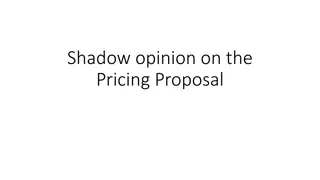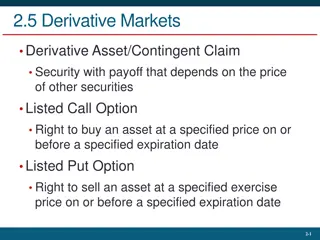Understanding Futures Markets: Mechanism and Pricing Dynamics
Futures markets play a crucial role in price convergence between futures and spot prices of underlying assets. Traders can exploit arbitrage opportunities when the futures price deviates from the spot price during the delivery period. Settlement of futures contracts can be done through offsetting, delivery, or close out, providing hedging and speculative options for market participants.
- Futures Markets
- Pricing Dynamics
- Arbitrage Opportunities
- Settlement Mechanisms
- Financial Engineering
Download Presentation

Please find below an Image/Link to download the presentation.
The content on the website is provided AS IS for your information and personal use only. It may not be sold, licensed, or shared on other websites without obtaining consent from the author. Download presentation by click this link. If you encounter any issues during the download, it is possible that the publisher has removed the file from their server.
E N D
Presentation Transcript
Futures Markets : Mechanism PAPER CC 303 MODULE -II FINANCIAL ENGINEERING S.MUKHERJEE
FUTURES PRICES AND SPOT PRICES The futures price converges to the spot price of the underlying asset as the delivery period for a futures contract is approached. When the delivery period is reached, the futures price equals or is very close to the spot price. Let us suppose that the futures price is above the spot price during the delivery period. Traders then have a clear arbitrage opportunity: they can 1. Sell (i.e., short) a futures contract 2. Buy the asset 3. Make delivery. These steps are certain to lead to a profit equal to the amount by which the futures price exceeds the spot price. As traders exploit this arbitrage opportunity, the futures price will fall.
FUTURES PRICES AND SPOT PRICES Suppose next that the futures price is below the spot price during the delivery period. Companies interested in acquiring the asset will find it attractive to enter into a long futures contract and then wait for delivery to be made. As they do so, the futures price will tend to rise. The result is that the futures price is very close to the spot price during the delivery period.
SETTLEMENT AND DELIVERY OF FUTURES Settlement of the futures contract can be done in three possible ways: Offsetting before maturity Delivery based Close out
OFFSETTING It is an effective way of Hedging due to convergence of the Futures price into the Spot Price. Thus by getting into an offsetting contract (sell if brought earlier or buy if sold earlier) nullifies the delivery requirements of the underlying asset . What remains to be settled is the price difference between the initial and the offsetting contracts. Offsetting is also called the Squaring up of the position. This option is preferred by both the hedgers and the speculators .
SETTLEMENT BY DELIVERY At NMCE contracts are delivered during last three days prior to the expiry date. No one is allowed to enter any fresh position in contracts that is about to expire in such a short span of time.
SETTLEMENT BY CLOSE OUT This option is resorted to by the exchange upon the expiry of open futures contract that are not squared up by the investors , if the exchange rules clearly stated that futures contracts are mostly cash settled . The necessity for cash settlement arises in case of future contracts based on (a) Hypothetical assets such as those on indices (b) Assets that are not permitted to be delivered due to laws of land . The contract specifies whether an exchange would resort to a close out or not. Settlement mechanism in the futures market essentially must provide for delivery so as to sustain an efficient price discovery and a strong linkage between the spot and the future markets
DELIVERY LOGIC There are several options available to exchanges to settle by delivery . They are prescribed as : Compulsory Both options Options of buyer and seller Assignment
OPEN INTEREST The number of contracts outstanding (not squared up) at any point of time is called open interest. With the initiation of the new contract , investors study the market of the underlying asset and assume an exposure on the futures contract Every buyer of a contract is matched by a seller. In general under normal circumstances the open interest rises with time and more and more investors start showing interest in the new contract and can assume either a long position or a short position based on their respective decisions. As the maturity of the contract approaches the investors tend to reduce their exposures and unwind their initial positions . Those who went long would initially unwind by selling their contracts and those who held short positions would end up in selling their contracts. The open interest would end up to zero as the contract tends to mature.
MARGINS: CONCEPTS If two investors get in touch with each other directly and agree to trade an asset in the future for a certain price, there are obvious risks. One of the investors may regret the deal and try to back out. Alternatively, the investor simply may not have the financial resources to honor the agreement. One of the key roles of the exchange is to organize trading so that contract defaults are avoided. This is where margins come in.
Since futures contracts are traded on formal exchanges, margin requirements, marking to market, and margin calls are required; forward contracts do not have these requirements. The purpose of these requirements is to ensure neither party has an incentive to default on their contract. Thus futures contracts can safely be traded on the exchanges between parties that do not know each other.
INITIAL MARGIN A margin is cash or marketable securities deposited by an investor with his or her broker. The balance in the margin account is adjusted to reflect daily settlement. Margins minimize the possibility of a loss through a default on a contract. Margin sometimes called the deposit represents security to cover any loss in the market value of the contract that may result from adverse price changes. This is the cost of trading in the futures market. Thus it is a percentage of the contract value and is prescribed by the exchange depending on the volatility in price of the underlying asset. An initial margin is required to be deposited to open a long or short position in the futures , and is normally set equivalent to the maximum loss that the position can suffer in a day.























